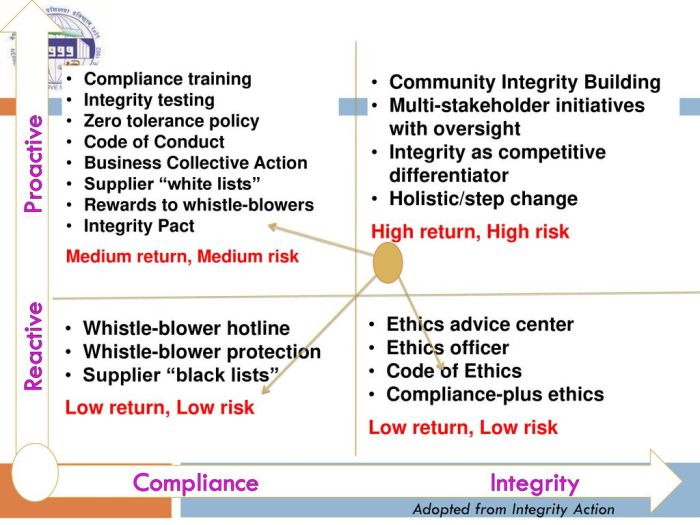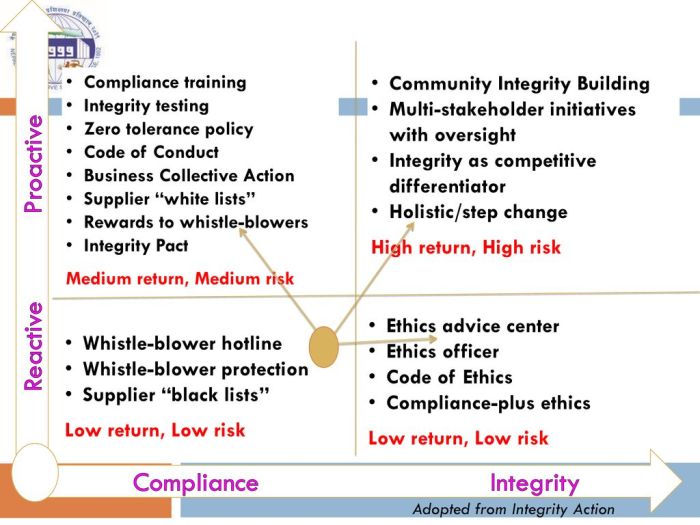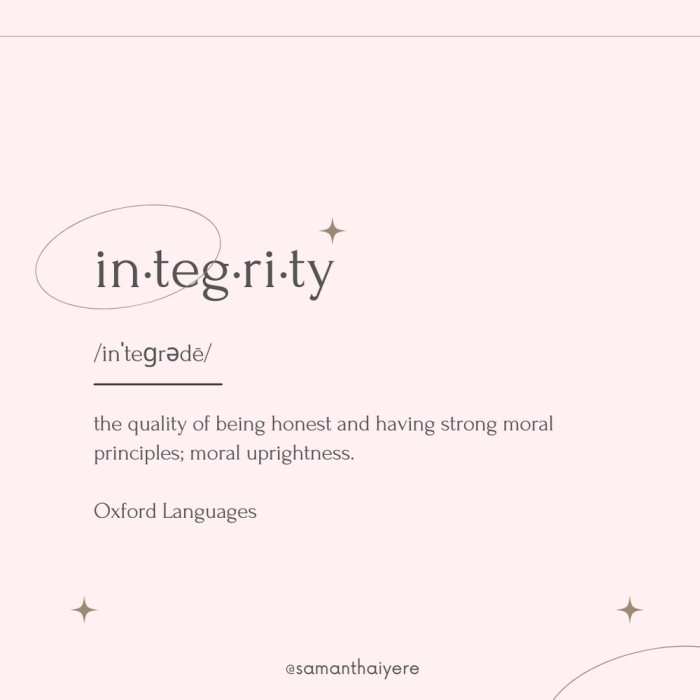Competitive Integrity, that’s the name of the game, folks. We’re diving deep into the world of fair play, exploring what it means, why it matters, and how technology, rules, and even our own attitudes shape the playing field. From the pros to the weekend warriors, we’ll uncover the impact of integrity (or lack thereof) on everyone involved. Think of it as the ultimate cheat sheet for understanding what makes a competition truly legit.
This exploration covers everything from defining competitive integrity itself and the different ways it’s upheld (or ignored!) across various sports and competitions. We’ll look at how technology influences fairness, the role of governing bodies, and how we can foster a culture where playing by the rules is not just expected, but celebrated. Get ready for some serious insights, some juicy case studies, and a whole lot of real-world examples.
Defining Competitive Integrity

Competitive integrity is more than just fair play; it’s the bedrock of any successful competition. It represents a commitment to ethical conduct, honesty, and respect for the rules and spirit of the game, ensuring a level playing field for all participants. This commitment fosters trust, builds credibility, and ultimately enhances the value and enjoyment of the competition itself.Competitive integrity encompasses a complex interplay of ethical conduct and strategic advantage.
While striving for victory is inherent in competition, the pursuit of that victory must never compromise ethical principles. The line between acceptable strategic planning and unethical behavior can be blurry, demanding careful consideration and self-regulation from all involved. For example, a coach meticulously analyzing opponent weaknesses and developing counter-strategies operates within the bounds of competitive integrity, while deliberately sabotaging an opponent’s equipment or spreading false rumors crosses that line.
Ethical Conduct in Competition
Ethical conduct forms the cornerstone of competitive integrity. This involves adherence to established rules and regulations, demonstrating respect for opponents and officials, and upholding the values of honesty, fairness, and sportsmanship. Examples of ethical conduct include accepting both victory and defeat gracefully, refraining from cheating or any form of deception, and reporting any observed violations of the rules.
A lack of ethical conduct undermines the integrity of the competition and erodes public trust. Consider the Lance Armstrong doping scandal; his actions not only deprived other cyclists of fair competition but also shattered the faith of millions of fans.
Strategic Advantage and the Boundaries of Integrity
The pursuit of strategic advantage is a legitimate and expected aspect of competition. Teams and individuals invest significant time and resources in developing innovative strategies, training regimes, and technological advancements to gain an edge. However, this pursuit must always remain within the ethical boundaries established by the governing rules and the broader principles of fairness and sportsmanship. For instance, employing cutting-edge data analytics to improve performance is acceptable, while using performance-enhancing drugs or manipulating match outcomes is not.
The key distinction lies in the methods used; integrity demands that the pursuit of advantage remains ethical and within the established rules.
Impact of a Lack of Competitive Integrity
The consequences of compromised competitive integrity are far-reaching and significantly impact various stakeholders. Athletes who cheat risk suspension, damage to their reputation, and loss of endorsements. Organizations face reputational damage, loss of sponsorships, and legal repercussions. Fans, disillusioned by dishonesty, may lose interest in the sport or competition, leading to a decline in viewership and revenue. For example, the FIFA corruption scandals severely tarnished the image of international soccer, leading to a loss of public trust and significant financial losses for the organization.
The damage to the overall sport is profound, extending beyond the immediate consequences of specific incidents.
Fair Play and Rules Enforcement

Maintaining competitive integrity hinges on the consistent and fair application of rules. Without clear guidelines and robust enforcement mechanisms, competitions lose their credibility, and participants are discouraged from striving for genuine victory. The existence of rules themselves acts as a framework for fair competition, ensuring a level playing field and preventing manipulation of outcomes.Rules and regulations provide a common understanding of acceptable behavior and expected conduct.
They define what constitutes a violation and what the consequences are, thereby deterring cheating and promoting ethical play. The effectiveness of these rules, however, is directly tied to the rigor and consistency of their enforcement.
Rule Enforcement Approaches Across Competitive Settings
Different competitive environments employ diverse approaches to rule enforcement, reflecting the unique challenges and contexts involved. In professional sports, for instance, a complex system of referees, umpires, league officials, and disciplinary committees is in place. These officials monitor gameplay, assess violations, and impose penalties ranging from warnings to suspensions and fines. This system relies heavily on real-time observation and immediate judgment calls.
In contrast, esports often utilize automated systems for rule enforcement, such as anti-cheat software and replay analysis. These technologies can detect subtle forms of cheating that might be missed by human observers, but they may also lead to false positives or fail to capture all forms of rule-breaking. Academic competitions, on the other hand, might rely on honor codes and peer review, with less formal mechanisms for addressing violations.
The chosen approach is always a balance between cost, effectiveness, and the specific needs of the competitive environment.
A Hypothetical System for Improved Rule Enforcement in Professional Esports
To enhance fair play in professional esports, a multi-faceted system could be implemented. This system would integrate automated detection systems with human oversight, leveraging the strengths of both approaches. Automated systems would continuously monitor gameplay for suspicious activity, flagging potential violations for review by a panel of expert referees. These referees, possessing deep knowledge of the game and its rules, would review flagged incidents, consider contextual factors, and render final decisions.
This two-tiered system could also incorporate a robust appeals process, allowing players and teams to challenge decisions they believe to be unjust. Transparency would be key, with publicly accessible records of all reported violations, investigations, and penalties. This system aims to minimize both false positives from automated systems and missed violations due to human error.
Common Violations and Penalties, Competitive Integrity
| Violation | Penalty (Example) | Competitive Setting | Severity |
|---|---|---|---|
| Cheating (e.g., using unauthorized software) | Disqualification, ban from future competitions, fine | Esports, Academic Competitions | High |
| Unsportsmanlike Conduct (e.g., verbal abuse, harassment) | Warning, suspension, fine | Professional Sports, Esports | Medium to High |
| Violation of Game Rules (e.g., illegal tackling in football) | Penalty (e.g., loss of yardage, free kick), suspension | Professional Sports | Low to Medium |
| Match Fixing | Lifetime ban, criminal charges | Professional Sports, Esports | Extremely High |
The Role of Governance and Oversight

Maintaining competitive integrity isn’t just about rules; it’s about the robust systems that enforce them. Governing bodies play a crucial role, acting as the guardians of fair play and ensuring a level playing field for all participants. Their effectiveness directly impacts the credibility and longevity of any competition.Governing bodies are responsible for establishing and enforcing rules, investigating potential breaches of integrity, and imposing sanctions when necessary.
This involves a complex interplay of policy creation, investigation, adjudication, and education. The effectiveness of this process varies significantly depending on the organization’s structure, resources, and commitment to fair play.
Governance Structures and Their Effectiveness
Different organizations utilize diverse governance models. Some employ centralized structures with a powerful governing body making all key decisions. Others favor decentralized models, distributing authority among various committees and stakeholders. The World Anti-Doping Agency (WADA), for example, operates on a collaborative model, involving national anti-doping organizations and international federations. In contrast, some smaller leagues might rely on a more centralized, single-entity approach.
The effectiveness of each model depends on factors such as transparency, accountability, and the resources available to enforce decisions. A centralized model can be efficient but may lack the diverse perspectives of a decentralized one. Conversely, decentralized models can be more responsive to specific needs but may suffer from inconsistencies in enforcement. Ultimately, the ideal structure balances efficiency with fairness and responsiveness.
Best Practices for Governing Bodies
Effective governance in sports requires a proactive and multi-faceted approach. A list of best practices includes:
- Clear and Accessible Rules: Rules must be unambiguous, easily accessible to all participants, and regularly reviewed and updated.
- Independent Investigation and Adjudication: Investigations into potential breaches of integrity should be conducted by independent bodies free from undue influence.
- Transparent and Consistent Sanctions: Sanctions should be proportionate to the offense and applied consistently across all participants, fostering a culture of accountability.
- Robust Education and Prevention Programs: Proactive education programs for athletes, coaches, and officials are crucial in preventing integrity violations before they occur.
- Whistleblower Protection: Establishing strong mechanisms to protect individuals who report suspected breaches of integrity is essential for fostering a culture of openness and accountability.
- Regular Audits and Reviews: Periodic audits and reviews of governance structures and processes ensure ongoing effectiveness and identify areas for improvement.
An Effective Anti-Doping Program
A comprehensive anti-doping program is a cornerstone of competitive integrity. Key components include:
- Testing Program: A robust testing program, encompassing both in-competition and out-of-competition testing, using a variety of methods (urine, blood, etc.) to detect prohibited substances. The program should be risk-based, targeting athletes most likely to use performance-enhancing drugs.
- Education and Prevention: Comprehensive education programs for athletes and support personnel about the dangers and consequences of doping, including the use of prohibited substances and methods. This should involve regular workshops, seminars, and online resources.
- Investigation and Sanctions: A thorough investigation process for suspected doping violations, including the collection and analysis of evidence, and the imposition of appropriate sanctions based on the severity of the offense. This often includes hearings and appeals processes.
- Therapeutic Use Exemptions (TUEs): A process for granting exemptions for the use of prohibited substances for legitimate medical reasons, requiring rigorous medical documentation and review.
- International Cooperation: Collaboration with international anti-doping organizations like WADA to ensure consistency and effectiveness in the fight against doping across different sports and nations.
Promoting a Culture of Integrity

Building a culture of integrity in competitive environments isn’t just about enforcing rules; it’s about fostering a genuine commitment to ethical conduct and fair play from every participant. This requires a multifaceted approach that integrates ethical principles into every aspect of the competitive experience, from training and development to competition itself. It’s about creating an environment where integrity isn’t just expected, but actively celebrated and reinforced.Creating a strong ethical culture necessitates a proactive strategy involving multiple stakeholders.
This includes competitors, coaches, officials, administrators, and even spectators. A collaborative effort is needed to establish clear expectations, provide consistent reinforcement, and implement effective mechanisms for addressing violations. The goal is to cultivate an environment where ethical behavior is not only the norm but also deeply ingrained in the mindset of everyone involved.
Methods for Fostering Ethical Conduct and Fair Play
Several strategies can effectively promote ethical conduct and fair play. These include clear communication of ethical standards, consistent enforcement of rules, and the creation of supportive environments that encourage ethical decision-making. Providing regular educational opportunities and readily available resources to address ethical dilemmas is crucial. Furthermore, rewarding ethical behavior and publicly acknowledging those who exemplify integrity can significantly reinforce desired conduct.
Establishing a robust reporting system for ethical violations, ensuring anonymity and protection for whistleblowers, is equally vital.
Examples of Successful Initiatives
The “True Sport” initiative, for example, focuses on building a culture of ethical sport through education and advocacy. Their programs emphasize athlete development, fair play, and respect for rules. Many national governing bodies in various sports have implemented similar initiatives, often involving educational workshops, online resources, and athlete pledges committing to ethical conduct. These programs frequently utilize case studies and real-life scenarios to help athletes understand the consequences of unethical behavior and learn how to navigate ethical dilemmas effectively.
Successful programs often incorporate peer-to-peer learning and mentoring opportunities, further solidifying the importance of ethical behavior within the competitive community.
Educational Programs for Ethical Decision-Making
Effective educational programs should go beyond simply stating rules. They should explore the underlying principles of ethical conduct, such as honesty, fairness, and respect. Interactive workshops, role-playing exercises, and case studies can help competitors develop critical thinking skills to navigate complex ethical dilemmas. These programs can also explore the long-term consequences of unethical behavior, not only on the individual but also on the reputation of the sport and its community.
The integration of technology, such as online modules and interactive simulations, can make these educational opportunities more accessible and engaging. Regular refresher courses and ongoing discussions can reinforce ethical principles and address emerging ethical challenges.
Integrating Integrity Principles into Training and Development
Integrating integrity into training and development isn’t an add-on; it’s a fundamental component of the process. Coaches and mentors should explicitly model ethical behavior and actively incorporate discussions about integrity into training sessions. This includes emphasizing the importance of respecting opponents, officials, and rules. It also means addressing instances of poor sportsmanship immediately and consistently. Team building exercises can be designed to promote collaboration, mutual respect, and a shared commitment to ethical conduct.
Regular evaluations that incorporate ethical considerations can further reinforce the importance of integrity. By making ethical considerations an integral part of the athlete’s development, a culture of integrity becomes organically ingrained.
FAQ Guide: Competitive Integrity
What happens if a governing body fails to enforce rules effectively?
It can seriously damage the credibility of the competition, erode trust among participants and fans, and lead to unfair advantages for some competitors. This can ultimately kill the sport or game.
How can technology be used to
-improve* competitive integrity?
Think instant replay in sports, drug testing advancements, or even AI-powered systems to detect cheating in online games. Technology offers tools to make competitions fairer and more transparent.
What role do fans play in maintaining competitive integrity?
Fans are crucial! Their support for fair play and their willingness to call out cheating help create a culture where integrity matters. Plus, they’re a powerful force that can pressure organizations to act.
Are there any examples of successful anti-doping programs?
The World Anti-Doping Agency (WADA) is a prime example. While not perfect, its global reach and commitment to testing and research have significantly impacted the fight against doping in sports.
